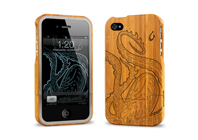The mobile phone accessory industry has an appalling reputation for wasting materials and energy in the pursuit of jumping on the latest trends and models. Portland’s Grove begs to differ
Consider the mobile telephone. Amongst the multitude of today’s gadgets, widgets and other ephemera we carry around in our pockets, it’s this that’s made the greatest difference to many people’s lives.

The ability to make a telephone call whenever you need to has now been supplanted by the smart device. It’s here that the digital frontier is developing. We’re not restricted to the desktop or even humble laptop anymore. If you need to connect, you reach in your Carhartt’s, pull out your device and take care of business. Even if that ‘business’ is ‘liking’ a picture of your friend’s second cousin’s cat taking a nap on Facebook.
While we’re not here to discuss the sustainable impact of the consumer electronics industry, the rise of the mobile phone has had a large effect on the production of what can only be described as cheap, crappy accessories. Think about your local phone shop and the racks of plastic accessories. If you want a diamanté encrusted Lady Gaga case for your iPhone, you can get it – and get it cheap – if that’s your bag.
You’ll also often find that the packaging alone for that dubious treasure uses more material, costs more to produce and fills up more landfill than the case itself.
Surely there’s another way?
I got to visit one company looking to do exactly that on a recent trip to Portland, Oregon. Taking a cab across the river and finding myself in a warehouse district that’s clearly going through something of a post industrial rebirth as a hot bed of development, I made my way through a renovated warehouse to the fifth floor. Opening the door with a warm smile and a handshake was Joe Mansfield co-founder of Grove.

Founded by Joe Mansfield and Ken Tomita, Grove is doing things differently and sustainably
Joe is no stranger to doing things differently. His first business, engraveyourbook.com, began providing laser etching services for lovers of nice notebooks, such as Moleskine.
During the early stages of the business he soon discovered that the covers were PVC and hitting them with a high powered laser caused some pretty nasty emissions (including phosgene, chlorine as well as producing hydrochloric acid). Many websites picked up on the advice posted on his website and Moleskine has been required to label its products properly since in several states in the US.
While setting up his business and dodging toxic gasses, Joe got talking to his next door neighbour, Ken. A furniture designer by training and profession, Ken Tomita is also a tinkerer with machines. The two discussed the rise of the iPhone and with Joe’s mastery of customisation of products with laser etching and Ken’s product design skills and knowledge of working with wood, Grove was born.
Grove is a perfect example of how traditional design and manufacturing skills can be combined with today’s digitally connected world to create something new, and something exciting.
Today the small team of friends creates customised cases for Apple devices. The current product range includes wood cases for the iPhone 4G and, of course, the iPad. As I toured round the facility, it quickly became apparent that this isn’t like other ‘iDevice’ accessory manufacturers. There’s no outsourcing of manufacture to the Far East to strip costs out of the product.
Everything is not only designed and developed in-house by Joe and Ken, but manufactured on-site too. While the admin and design office occupies a light airy space with an enviable view of where the Willamette and Columbia rivers meet, the real work takes place on the ground floor. Here, Grove has a set of workshops where the products are manufactured, finished, packaged and distributed.
A bank of two Haas machine tools are complimented by a highly skilled team that hand assemble and finish each product manually to achieve the best results.

Grove’s new iPad 2 case combines bamboo with leather (and magnets) into one delightful product
The products are manufactured from rapidly renewable bamboo and vegetable tanned domestic leather. What’s interesting is how the team’s desire to be responsible has influenced the design process.
Cutting intricate products from bamboo stock will obviously create a great deal of waste as material is removed. Here, Joe and Ken’s ingenuity came into effect as they both realised that the waste materials from the bamboo stock was perfect for creating aesthetically pleasing packaging. All of Grove’s products are now shipped using these off cuts, which traditionally would have been waste.
They study the new models as soon as details start to filter out of Infinite Loop and from other sources to get their products ready. As with all things related toApple, the secrecy involved means that they’re developing the products before official specs are available. With the iPad2 having just been announced, the timing of my visit couldn’t have been better as Ken and the team were fine tuning the production units.
What struck me was the element of craft. Having grown up with parents that hoarded high-quality furniture, it was fascinating to visit a company that takes its work seriously, brings elements of craft back into a rather ruthless industry sector. The new models feature a black bezel of mind blowing accuracy and fit/finish that harks back to cabinet making of centuries past. These aren’t objects that are used passively. Hold one in your hand and there’s an immediate desire to look, touch and feel its curves. Something which makes people cherish them.
With the iPad 2 product now online and selling like proverbial hot cakes, with new and ever growing customisation options it’s clear that Grove is doing things differently, doing things responsibly and innovating in a cut throat market.
www.grovemade.com
Oregon firm presents a strong case for green manufacturing
No
Default






